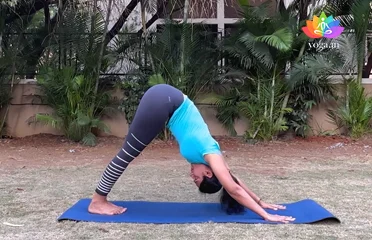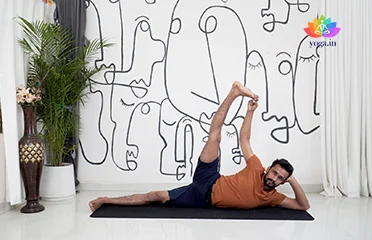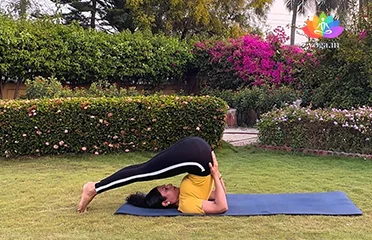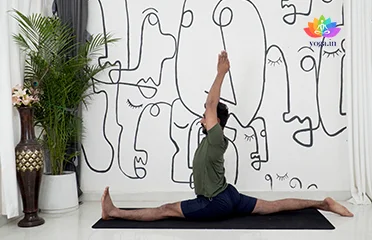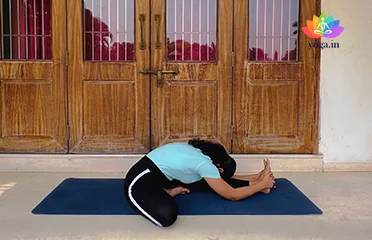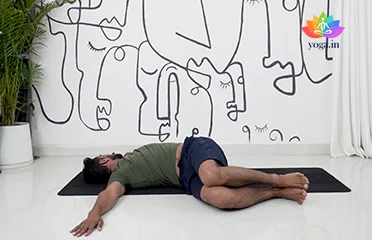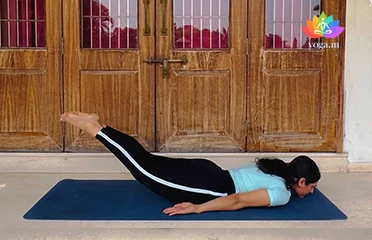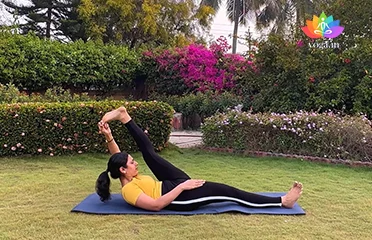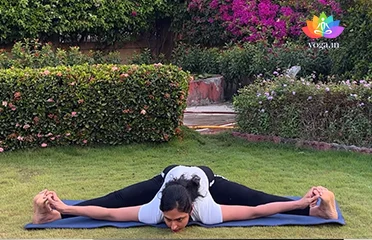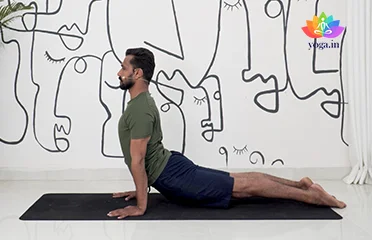Adho Mukha Svanasana (Downward-Facing Do
अधोमुख श्वानासन / Downward-Facing Dog Pose
The sanskrit name is derived from adhas (अधस्) meaning down, mukha [�K]
Anantasana (Sleeping Vishnu Pose)
अनन्तासन / Sleeping Vishnu Pose | Vishnu's Couch Pose
The Sanskrit name is derived from Ananta (अनन्त) meaning without end [�K]
Halasana (Plough Pose)
हलासन / Plough Pose
The Sanskrit name is derived from Hala (हला) meaning plough and asana [�K]
Hanumanasana (Monkey Pose)
हनुमानासन / Monkey Pose
The Sanskrit name is derived from the Hindu God -Hanuman (हनुमान) [�K]
Janusirsasana (Head to Knee Pose)
जानुशीर्षासन / Head to Knee Pose
The Sanskrit name is derived from (जानु) Janu means knee, Sirsa (शीर्षा) [�K]
Jathara Parivartanasana (The Abdominal T
ञठर परिवर्तनासन / The Abdominal Twist
The Sanskrit name is derived from Jathara (ञठर) meaning belly or abdomen, [�K]
Shalabhasana (Locust Pose)
सलभासन / Locust Pose
The Sanskrit name is derived from Shalabha (शलभा) meaning locust and [�K]
Supta Padangusthasana (Reclining Posture
सुप्त पदंगुष्टासन / Reclining Posture
The Sanskrit name is derived from Supta (सुप्त) meaning 'supine or [�K]
Upavishta Konasana (Wide-Angled Seated F
उपविष्ट कोनासन / Wide-Angled Seated Forward Bend
The Sanskrit name is derived from Upavistha (उपविष्ट) means open/seated, [�K]
Urdhva Mukha Svanasana (Upward-Facing Do
ऊर्ध्वमुखश्वानासन / Upward-Facing Dog Pose
The Sanskrit name is derived from Urdhva (ऊर्ध्व) meaning up, Mukha [�K]
How Yoga Can Help Cure Deformity in Legs:
Leg deformities can include conditions such as bow legs, knock knees, and flat feet, which affect the alignment and function of the legs. Yoga can aid in the treatment and relief of these deformities by promoting proper alignment, strengthening muscles, and enhancing flexibility. Regular practice of specific yoga poses can correct posture, balance muscle strength, and improve overall leg function.
Understanding Deformity in Legs:
Leg deformities refer to any abnormal alignment or shape of the legs that can affect mobility and function. These deformities can be present at birth (congenital) or develop over time due to various factors. Common types of leg deformities include:
- Bow Legs (Genu Varum): Legs curve outward at the knees while the feet and ankles touch.
- Knock Knees (Genu Valgum): Knees touch while there is a gap between the ankles.
- Flat Feet (Pes Planus): The arches of the feet are flattened, causing the entire foot to touch the ground.
Yoga’s Role in Relieving Deformity in Legs:
Specific yoga practices can significantly alleviate symptoms of leg deformities. Here’s how:
- Bow Legs: Yoga poses that strengthen the inner thighs and lengthen the outer thighs can help realign the legs.
- Knock Knees: Strengthening and stretching exercises for the outer thighs and hip abductors can correct knee alignment.
- Flat Feet: Poses that strengthen the arches of the feet and improve foot flexibility can support better foot structure.
Key Factors Contributing to Deformity in Legs:
Different factors contribute to each type of leg deformity
- Genetics: Family history of leg deformities can increase the likelihood of developing similar conditions.
- Nutritional Deficiencies: Lack of essential nutrients, especially during childhood, can affect bone growth and alignment.
- Injuries: Trauma or injuries to the legs can lead to improper healing and deformities.
- Poor Posture: Consistent bad posture and improper alignment can cause or exacerbate leg deformities.
Symptoms of Deformity in Legs:
Common symptoms include
- Bow Legs: Noticeable outward curvature of the legs, difficulty walking or running, and joint pain.
- Knock Knees: Inward angle of the knees, clumsiness while walking, and discomfort in the knees.
- Flat Feet: Lack of arch in the foot, pain in the feet and ankles, and difficulty standing for long periods.
Treatment of Deformity in Legs through Yoga and Pranayama:
Yoga and pranayama can be highly beneficial for treating leg deformities. Recommended practices include:
Specific Yoga Poses:
Bow Legs:
- Virabhadrasana II (Warrior II Pose): Strengthens the legs and helps correct alignment.
- Baddha Konasana (Butterfly Pose): Opens the hips and strengthens inner thighs.
Knock Knees:
- Utthita Trikonasana (Extended Triangle Pose): Strengthens and stretches the thighs, improving alignment.
- Ardha Chandrasana (Half Moon Pose): Strengthens the outer thighs and hips.
Flat Feet:
- Tadasana (Mountain Pose): Encourages proper foot alignment and strengthens the arches.
- Vrikshasana (Tree Pose): Improves balance and strengthens the muscles supporting the arches.
Pranayama Exercises:
- Anulom Vilom (Alternate Nostril Breathing): Balances the body and mind, reducing stress and promoting healing.
- Ujjayi Breath (Ocean Breath): Enhances focus and helps maintain steady breathing during yoga practice.
Diet for Deformity in Legs:
A balanced diet rich in calcium, vitamin D, and protein is essential for bone health and muscle strength. Include foods like:
- Dairy products, leafy greens, and fortified cereals for calcium.
- Fatty fish, egg yolks, and sunlight exposure for vitamin D.
- Lean meats, legumes, and nuts for protein.
Caution for Deformity in Legs:
When practicing yoga for leg deformities:
- Avoid poses that cause pain or discomfort.
- Focus on alignment and proper form to prevent injury.
- Practice under the guidance of a qualified yoga instructor.
Contraindications for Deformity in Legs:
People with severe deformities or those recovering from surgery should:
- Avoid high-impact poses that can strain the legs.
- Refrain from poses that exacerbate their condition.
- Consult a healthcare provider before starting yoga.


